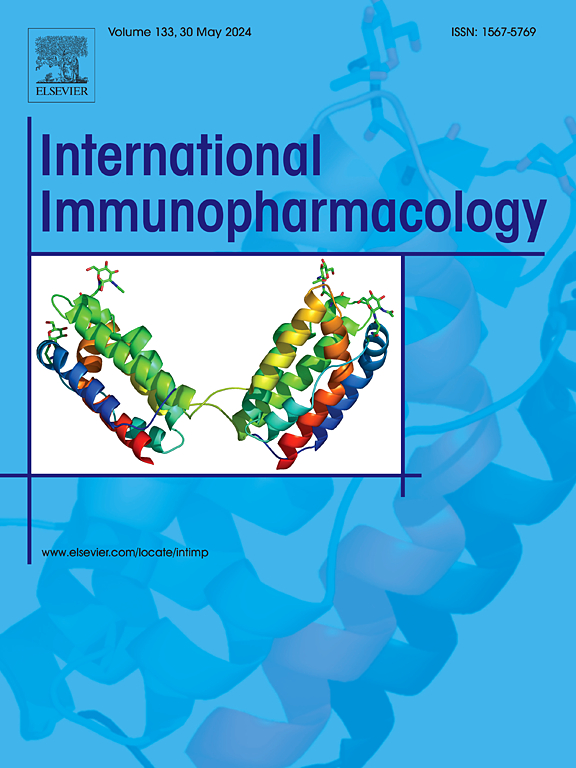野葛根皂苷 R1-儿茶醛通过增加一氧化氮的释放来抑制血管平滑肌细胞中的 TGFβR1-YAP/TAZ 通路,从而减少血管炎症和钙化。
IF 4.8
2区 医学
Q2 IMMUNOLOGY
引用次数: 0
摘要
血管钙化是导致脆弱的动脉粥样硬化斑块破裂,最终引发心血管疾病的一个重要因素。然而,目前还没有有效的治疗方法来减缓血管钙化的进展。从三七和丹参中提取的主要活性成分--三七皂苷 R1(R1)和原儿茶醛(PCAD)在减轻内皮损伤和动脉粥样硬化方面具有潜力。本研究调查了 R1-PCAD 对内皮细胞(ECs)一氧化氮(NO)产生的影响及其在对抗血管钙化和炎症中的作用。此外,研究还探讨了这些作用的机制。为了模拟动脉粥样硬化钙化,研究人员给载脂蛋白E缺陷(ApoE-/-)小鼠喂食高脂肪食物,并腹腔注射维生素D3。使用 R1-PCAD 组合治疗可改善内皮功能、减少主动脉炎症并降低钙沉积。从机理上讲,R1-PCAD通过激活AMPKα/Akt途径增强了eNOS-Ser1177磷酸化,从而刺激了NO的产生和心血管细胞中eNOS的活化。在血管平滑肌细胞(VSMC)和心血管细胞的体外共培养模型中,R1-PCAD 同样减少了β-甘油磷酸酯引发的血管平滑肌细胞的炎症和钙化,这些作用部分取决于 NO 水平和心血管细胞的功能。进一步研究发现,R1-PCAD 促进了血管内皮细胞释放 NO,从而抑制了血管内皮细胞中 TGFβR1 的活化。这种抑制作用减少了 Smad2/3 的活化和 YAP/TAZ 的核转位,从而减轻了血管内皮细胞的炎症和钙化。这些发现表明,R1-PCAD 主要通过 NO-TGFβR1-YAP/TAZ 信号通路缓解血管炎症和钙化。这项研究为通过靶向细胞间信号通路治疗血管钙化提供了一种前景广阔的新方法。本文章由计算机程序翻译,如有差异,请以英文原文为准。
Notoginsenoside R1-Protocatechuic aldehyde reduces vascular inflammation and calcification through increasing the release of nitric oxide to inhibit TGFβR1-YAP/TAZ pathway in vascular smooth muscle cells
Vascular calcification is a significant factor contributing to the rupture of vulnerable atherosclerotic plaques, ultimately leading to cardiovascular disease. However, no effective treatments are currently available to slow the progression of vascular calcification. Notoginsenoside R1 (R1) and protocatechuic aldehyde (PCAD), primary active components extracted from Panax notoginseng and Salvia miltiorrhiza Burge, have shown potential in mitigating endothelial injury and atherosclerosis. This study investigated the effects of R1-PCAD on nitric oxide (NO) production in endothelial cells (ECs) and its role in counteracting vascular calcification and inflammation. Additionally, it explored the mechanisms underlying these effects. To simulate atherosclerotic calcification, apolipoprotein E-deficient (ApoE−/−) mice were fed a high-fat diet and given intraperitoneal injections of vitamin D3. Treatment with the R1-PCAD combination improved endothelial function, reduced inflammation in the aorta, and lowered calcium deposition. Mechanistically, R1-PCAD enhanced eNOS-Ser1177 phosphorylation by activating the AMPKα/Akt pathway, which stimulated NO production and eNOS activation in ECs. In an in vitro co-culture model involving vascular smooth muscle cells (VSMCs) and ECs, R1-PCAD similarly reduced inflammation and calcification in VSMCs triggered by β-glycerophosphate, with these effects partially dependent on NO levels and EC functionality. Further investigation revealed that R1-PCAD facilitated NO release from ECs, which subsequently inhibited TGFβR1 activation in VSMCs. This inhibition reduced Smad2/3 activation and nuclear translocation of YAP/TAZ, thereby diminishing inflammation and calcification in VSMCs. These findings suggest that R1-PCAD alleviates vascular inflammation and calcification primarily via the NO-TGFβR1-YAP/TAZ signaling pathway. This study presents a promising new approach for treating vascular calcification by targeting intercellular signaling pathways.
求助全文
通过发布文献求助,成功后即可免费获取论文全文。
去求助
来源期刊
CiteScore
8.40
自引率
3.60%
发文量
935
审稿时长
53 days
期刊介绍:
International Immunopharmacology is the primary vehicle for the publication of original research papers pertinent to the overlapping areas of immunology, pharmacology, cytokine biology, immunotherapy, immunopathology and immunotoxicology. Review articles that encompass these subjects are also welcome.
The subject material appropriate for submission includes:
• Clinical studies employing immunotherapy of any type including the use of: bacterial and chemical agents; thymic hormones, interferon, lymphokines, etc., in transplantation and diseases such as cancer, immunodeficiency, chronic infection and allergic, inflammatory or autoimmune disorders.
• Studies on the mechanisms of action of these agents for specific parameters of immune competence as well as the overall clinical state.
• Pre-clinical animal studies and in vitro studies on mechanisms of action with immunopotentiators, immunomodulators, immunoadjuvants and other pharmacological agents active on cells participating in immune or allergic responses.
• Pharmacological compounds, microbial products and toxicological agents that affect the lymphoid system, and their mechanisms of action.
• Agents that activate genes or modify transcription and translation within the immune response.
• Substances activated, generated, or released through immunologic or related pathways that are pharmacologically active.
• Production, function and regulation of cytokines and their receptors.
• Classical pharmacological studies on the effects of chemokines and bioactive factors released during immunological reactions.

 求助内容:
求助内容: 应助结果提醒方式:
应助结果提醒方式:


